#ube puto cheese
Text
Ube Puto Cheese | Iwas palpak tips
Ube Puto Cheese | Iwas palpak tips
Proverbs 24:16, “For the righteous falls seven times and rises again, but the wicked stumble in times of calamity.”
To God be the glory!
youtube
View On WordPress
#do&039;s and don&039;ts for making puto cheese#iwas palpak tips#palpak tips#puto cheese#ube#ube puto cheese#Youtube
0 notes
Text
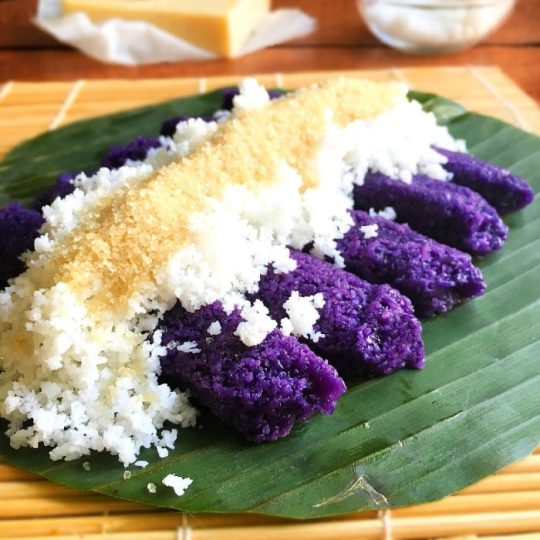
Puto Bumbong (Vegan-Friendly)
#vegan#desserts#street food#filipino cuisine#puto bumbong#glutinous rice flour#ube#coconut#coconut condensed milk#vegan butter#coconut milk#vegan cheese#cane sugar
21 notes
·
View notes
Text

here is a filipino bakery breads pt. 1!
mamon : soft fluffy bread, very light and airy sponge cake.
egg pie : filipino pie with egg custard filling.
puto : a steamed rice cake made from slightly fermented rice.
spanish bread : bread roll shape with a traditional sweet filling made of butter or margarine and brown sugar and sprinkled with bread crumbs on the outside.
yema cake : chiffon cake with custard filling
ensaymada : filipino style brioche, tender, fluffy, light and sweet. popular in the Philippine bakeries.
ube cheese bread : combination of intense purple yam and cheese. a soft fluffy bread with cheese filling and a purple yam bread.
cheese bread : creamy, sweet and savoury cheese soft bread.
star bread : (popular as "putok") because of the design in the top. it looked like it popped. also topped with white sugar.
kalihim : (popular as "pan de regla") pink bread pudding filling made from stale bread with a mix of sugar, butter, eggs, milk and vanilla.
kabayan : soft muffin with a distinct shape of "salakot". can be toasted at the edges too.
pan de coco : fluffy bread roll filled with sweetened coconut.
#artists on tumblr#digital artist#artist#artistsupport#art#digital art#drawing#illustration#my art#artistsoninstagram#foodie#food art#food illustration#filipino#pastries#breadmaking#breads
149 notes
·
View notes
Text
YKNOW WHAT- YOU CANT STOP ME IM GOING TO DELETE HALF OF THIS ANYWAY WHEN THE ANXIETY KICKS IN HERES SOME GOOD FOOD:
-Halo-Halo, this one isn't my thing personally but people tend to like it. It's usually coconut milk, beans, jello, ube ice cream- uh, few other things I dont remember. Try it out maybe you'll like it more than me.
(Once Again I think Amane should eat Ube because its TECHNICALLY a vegetable- no dont look at how its usually used in desserts its totally not sweet and nutty)
-Taho, uh...im gonna be honest I dont know exactly what Taho is, it's sago and then syrup and then other stuff...its really good though!
-Puto, is this all desserts? Uh...dont look at me- This is a rice cake! Yet again I think Amane could be loopholed into eating this, sometimes its topped with things like cheese. I love these things there very squishy.
-Adobo! My beloved adobo! I can't describe it properly so here's my dear friend Wikipedia:
meat, seafood, or vegetables first browned in oil, and then marinated and simmered in vinegar, salt and/or soy sauce, and garlic.
Cant go wrong with adobo, it's a good thing.
-Mamon, chiffon or sponge cake but like also a cupcake, very soft, usually slathered in butter and cheese and other things. Its also incredibly delicious
-There's more food but like....go put these down as thing you should try one day-
19 notes
·
View notes
Text
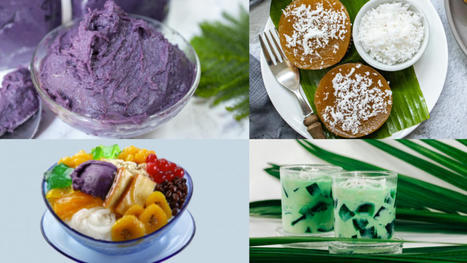
10 Most Insanely Good Filipino Merienda
Sweets produce “happiness hormones.” In fact having that sweet dessert after a hearty feast is the most satisfying part of the meal.
Filipinos typically prepare delicious treats that the whole family will enjoy using tropical ingredients like coconuts and fruits. Rice, particularly sticky rice and even glutinous rice, is a common ingredient used in merienda recipes like the famous sapin-sapin and palitaw.
The sweet treats you hear about such as a special Halo-halo are just a tiny portion of the fantastic merienda that Filipinos enjoy! Anyone can have a taste of these authentic Filipino recipes at the Manila Food Mart ,Lake Forest, Orange County.
Let’s see how much you know about some yummy Filipino merienda favorites! Read on!
#1 Buko Pandan
Talking about a crowd pleaser during gatherings, Buko Pandan is one of them. There are three main ingredients in this sweet and cooling Filipino treat: Sweetened cream, gelatin laced with pandan, and coconut.
Is it difficult to prepare? All you need to do is combine all the ingredients with the right proportion, then refrigerate it. A bowl of joy is in your hands after a few hours! Buko Pandan is aromatic and coconutty. This dessert is truly tropical and no wonder, a winner at every birthday party or during simple warm midday.
#2 Cassava Cake
Gluten-free diet? Good news for you!
The name Cassava Cake refers to a classic Filipino cake made with grated cassava and coconut milk coated with molten custard at the top. Its texture is interestingly firm but also soft and just a little chewy. The ingredients used are absolutely gluten-free!
The extra ingredients from making the cake itself also work perfectly as toppings! The most well-liked ones include Macapuno, a sweet type of Filipino coconut, and light cheddar cheese shreds to balance everything. Yum!
#3 Turon
Thought you could never be satisfied with Lumpiang Shanghai? Wait until you try Turon!
Falling in the category of widely consumed lumpia dishes, Turon is one of its sweet varieties. Made with Saba banana and jackfruit wrapped in a thin wheat wrapper, you can never miss this famous Filipino treat hitting the street when it’s Merienda time! Fried to a golden crisp, turon can be drizzled with caramel or dusted with roasted sesame seeds.
#4 Biko
Feel the love of a family member preparing that famous Biko. This tasty merienda favorite demands time and patience to perfect! It involves stirring the sticky rice consistently to prevent it from sticking to the pot and preparing another recipe for the top layer known as Latik. It somehow resembles cassava cake in appearance given that Biko is also a type of rice cake.
This delicious dessert commonly prepared on birthdays, holidays, and special occasions, is sticky, fragrant, and nutty sweet! Why not welcome Biko in your next gathering?
#5 Puto
Despite its neutral flavor, Puto is a favorite rice cake especially when it is served with a tasty dinuguan.
A wide variety of Puto with variations in consistency, form, size, color, and flavor is a product of the playful Pinoy taste bud. Some Puto are cooked with a delicious pork filling while some have variations in flavor like the Ube Puto. Others would rather stick to the usual strip of cheese and salted egg at the top.
Puto is equally as versatile as the Filipinos themselves!
#6 Kutsinta
This orange variant of the traditional Filipino steamed rice cake is just as well-liked and delectable!
Kutsinta has the same fundamental ingredients as most rice cakes, but the presence of food-grade lye produces a thick and chewy texture. Also, brown sugar and annatto seeds are what give it a hint of orange color. It is commonly sold together with Puto, and Filipinos love to eat them together too! Why not give this nostalgic combination a try!
#7 Leche Flan
Leche Flan has that sweet, creamy flavor that nearly no one could possibly resist!
Leche flan may look familiar because it is similar to Creme Caramel. It is a pudding that the Filipinos steam cook with milk, sugar, eggs, and vanilla flavoring. It is so delicious that it smoothly and slowly melts in your mouth!
A perfectly cooked Leche flan has achieved a silky soft texture and is typically oval-shaped for using tin molds called ‘llaneras‘ to prepare.
Serve this simple yet luscious dessert chilled and drizzled with caramel syrup for the perfect indulgence!
#8 Halo-halo
Halo-halo means “mix-mix” or “assorted,” and it perfectly describes the dish’s technique and style! Discover why it’s worthwhile to try this festive Filipino dish that you’ve probably heard about on social media a lot!
Bananas, sweet potatoes, jackfruit, and red mongo beans are among the most commonly used ingredients in this fruit and bean combination summer snack. But do you still remember Leche Flan? It is also one of the more appealing ingredients to add along with various colorful cubes of fruit jellies. It is then finished off with finely crushed ice, milk, and a scoop of Ube ice cream at the top!
Let this combination of various sweet delights and superb eye-pleasing cold dessert comfort you! Visit Manila Food Mart and be ready for a great serving of an authentic Halo-halo.
But wait, a photo of this fresh Halo-halo will surely be great for your next Instagram post!
#9 Taho
Tahooooo?! Anyone?
For many Filipinos, this traditional dessert Taho evokes flashbacks of their youth in the Philippines.
Identical desserts may be found in many Asian countries, especially the silkiest tofu variety. Similar practices apply to Pinoy Taho, but Filipinos prefer a sweet arnibal syrup with tiny sago pearls in their hot Taho.
Early in the morning, street vendors routinely sell this very affordable, tasty, high-protein breakfast item. A cup of Taho is every kid’s favorite treat! How about reliving the nostalgia?
#10 Ube Halaya
There are a lot of tasty desserts and merienda to try in the Philippines. Pinoys love to play around with different sweet treats to find the right balance of taste. Ube Halaya is one of these deliciously well-balanced desserts. It has a soft, creamy consistency and a mildly sweet taste.
Ube Halaya is one of these deliciously well-balanced desserts. Patiently cook a perfect purple yam or Ube with some milk and sugar. Mix to get that sticky, smooth texture and you will have that heavenly Halaya.
Dig in! Enjoy a truly sweet treat that you can never resist!
The Sweet Conclusion
Merienda can mean either sweet or savory food in the Philippines. It is a habit that is hard to break, a time to eat your favorite turon, halo halo or rice cakes!
And whether you have a sweet tooth or none at all, a handful of these Filipino sweet treats for your merienda satisfies those cravings.
Great that Manila Food Mart in Orange County has prepared those authentic and affordable merienda treats for you and your family.
Delight those taste buds! Bring back nostalgia! Visit Us!
#filipinoRestaurantOrange County#FilipinoFoodLakeForest#FilipinoFoodOrangeCounty#authenticFilipinoFoodLakeForest#bestrestoOrangeCounty#Best Filipino Restaurant Orange County#TuroturoOrangeCounty#BestCateringOrangeCounty
3 notes
·
View notes
Text
Kakanin Delights: A Culinary Journey through Bibingka, Kutsinta, and Puto in the Philippines
Kakanin, a treasured Filipino delicacy, stands as a culinary cornerstone in the Philippines, cherished by both locals and visitors. Comprising a delectable blend of rice, coconut milk, and various flavorful ingredients, kakanin offers a distinctive and indulgent taste experience. In this insightful food review, the spotlight is on three iconic kakanin dishes: bibingka, kutsinta, and puto, each contributing to the rich tapestry of Filipino culinary heritage.
Bibingka takes center stage as a must-try kakanin, particularly during the festive Christmas seasons. This thick, fluffy, and savory rice cake undergoes a unique preparation, cooked in a clay pot with banana leaves, resulting in a slightly charred and caramelized exterior paired with a soft and moist interior. The infusion of coconut milk and the aromatic essence of banana leaves add layers of flavor, and the finishing touch of grated cheese and butter transforms it into a heavenly treat balancing sweetness and savoriness.
Moving on, kutsinta emerges as a sticky, chewy delight, distinguished by its translucent appearance colored with annatto extract. This snack or dessert option captivates with its pleasingly chewy consistency and a subtle sweetness. Notably, variations with toppings such as grated coconut or caramel syrup contribute to a richer flavor and texture profile, making kutsinta a popular choice found in local markets, bakeries, and street food stalls. Finally, the spotlight turns to puto, a fluffy and steamed rice cake often enjoyed for breakfast or merienda. Puto's soft and airy texture, combined with various flavors like ube or pandan, adds a unique twist to the traditional recipe, creating a delightful experience that almost melts in the mouth. Together, these kakanin dishes represent a diverse and delightful exploration of Filipino culinary heritage, offering comfort and joy to those who savor these traditional rice cakes.
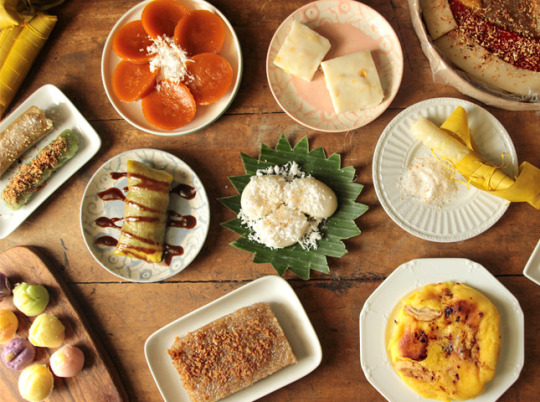
1 note
·
View note
Text
Friends and Family Features Nostalgic Family-Friendly Diner
Remember your childhood birthday parties which somehow had the best-tasting spaghetti you’ve ever had? What about those old family gatherings with cousins and grandparents where everyone enjoyed eating all their favorite Filipino dishes? Those memories don’t have to fade away because you can make new memories and celebrate with friends and family once again at Friends and Family in Bonifacio Global City.
The aptly-named Friends and Family is a tribute to Manila's neighborhood eateries and diners of yesteryears. This casual, family-friendly restaurant is located at the busy Bonifacio High Street Central where family gatherings and barkada get-togethers usually take place. It offers twists on our favorite comfort food while also serving classics that you may have already forgotten.
Friends and Family is open from as early as 8:00am all the way to 10:00pm. It is owned and managed by Raintree Hospitality which also gave us other notable restaurants such as Saboten, Providore, Jones All Day, Farmer’s Table Tagaytay, and more.
You can drop by Friends and Family for breakfast, merienda, lunch, dinner, or desserts. The bakery section offers many options for those quick snacks on the go. One of their new specialties is the Spanish Bread Croissant with a sweet and thick custard filling.
Our group of friends, who I’ve come to treat as my own family, gathered at Friends and Family to sample their many comfort food dishes as well as some new breakfast items.
We started with some Refreshers like the Fresh Buko in the Shell (P275). They also have other beverages like Sago’t Gulaman and Coconut Mango Shake.
I ordered the Saba Langka (P195) for myself which is like a drink and dessert in one. Other interesting options include the Buko Pandan, Ube Macapuno, Yema Crema, and more.
For our appetizers, we had the Crispy Tofu & Mushroom (P280). This sizzling plate of “pulutan” comes with crispy tofu, mushrooms, and kangkong with bell peppers.
Another fantastic starter would be the Cheesy Garlic Butter Scallops (P280) topped with breadcrumbs, calamansi and garlic pasrley butter. I loved how garlicky and cheesy these scallops are and I almost finished this entire serving myself.
The Crispy Catfish & Buro Platter (P295) is a unique Filipino salad dish that needs some participation from the guest. Grab one of the mustasa leaves and place some of the green mango salad, red onions, fresh ginger, ground peanuts, calamansi, patis, garlic and fresh chilies inside. Top it off with their homemade buro, wrap it all together then take a bite.
Filipinos love to eat dinuguan so the Day 2 Dinuguan at Puto (P175) will be a crowd favorite. This pork blood stew is topped with spring onion, fried green chili and lemongrass then served with puto which is a steamed rice cake that goes well with savory dishes.
The Dinakdakan is an Ilocano dish similar to the popular sisig of Pampanga but with just a little difference. The grilled pork is served with mayonaisse and spices and has bigger chunks compared to the sisig.
One of the most popular dishes at Friends and Family is their Birthday Spaghetti with Hotdog and Marshmallow (P225). This Filipino-style spaghetti has a sweet house made beef sauce topped with grated cheddar cheese. No matter what others say, I think Filipinos want their spaghetti like this instead of the more authentic Italian style.
This was also a special day for us because we were also celebrating the birthday of The KTG founder, Spanky Enriquez, who got how own plate of birthday spaghetti with a special song and greeting from the staff. Of course, I got the marshmallow and hotdog for myself.
What goes well with Pinoy spaghetti? Barbecues! You can order these barbecue sticks per piece like the BBQ Pork Tenga (P85), Isaw Bilog (P65), Isaw Manok (P55), and Special Pork BBQ (P125).
One of my favorites that afternoon was Chef K’s Crispy Tortang Talong (P250) served with banana ketchup vinaigrette. The eggplant was so crispy on the outside but still soft on the inside.
Then there’s the classic Pork Binagoongan (P325) with its crispy pork belly together with eggplant, tomato, and F&F Salsa.
What is a Filipino meal without rice? There are several rice dishes to choose from but one of the favorites here is the Tinapa Rice (P280) prepared with salted egg and F&F salsa.
Friends and Family actually serves breakfast daily from 8:00am to 11:00am so we also tried a few of their morning offerings. The Longanisa Omelette (P350) comes with an interesting combination of longanisa, pimientos, cheese, onions, and kangkong then topped with hollandaise and served with salad and pandesal brioche.
I still prefer having rice during breakfast so the Two Way U.S. Beef Tapa (P375) is my choice. It has crispy beef flakes and their famous Jones Tapa with garlic rice, two eggs, atchara, Tagaytay piña and green beans for a complete breakfast set.
For something different, try the Grilled Bacon Tocino Benedict (P395) which is a Filipino twist on the Eggs Benedict. This version is served with tocino and egg on a pandesal brioche then doused with calamansi hollandaise.
For dessert, we had the classic Leche Flan (P125) but they also have other desserts like Ube Tres Leches, Ultimate Halo Halo, Jackfruit Sansrival, and more. Friends and Family is truly a perfect place to celebrate with all your family and friends. Make your reservations early this holiday season and I’m sure you will all have some great bonding moments.
Friends and Family
7th Ave & 30th Street, Bonifacio High Street Central, Bonifacio Global City, Taguig
(0917) 891-7053
www.facebook.com/raintreefriendsandfamilyph
raintreehospitality.net
0 notes
Text

10 Most Insanely Good Filipino Merienda
Sweets produce “happiness hormones.” In fact having that sweet dessert after a hearty feast is the most satisfying part of the meal.
Filipinos typically prepare delicious treats that the whole family will enjoy using tropical ingredients like coconuts and fruits. Rice, particularly sticky rice and even glutinous rice, is a common ingredient used in merienda recipes like the famous sapin-sapin and palitaw.
The sweet treats you hear about such as a special Halo-halo are just a tiny portion of the fantastic merienda that Filipinos enjoy! Anyone can have a taste of these authentic Filipino recipes at the Manila Food Mart ,Lake Forest, Orange County.
Let’s see how much you know about some yummy Filipino merienda favorites! Read on!
#1 Buko Pandan
Talking about a crowd pleaser during gatherings, Buko Pandan is one of them. There are three main ingredients in this sweet and cooling Filipino treat: Sweetened cream, gelatin laced with pandan, and coconut.
Is it difficult to prepare? All you need to do is combine all the ingredients with the right proportion, then refrigerate it. A bowl of joy is in your hands after a few hours! Buko Pandan is aromatic and coconutty. This dessert is truly tropical and no wonder, a winner at every birthday party or during simple warm midday.
#2 Cassava Cake
Gluten-free diet? Good news for you!
The name Cassava Cake refers to a classic Filipino cake made with grated cassava and coconut milk coated with molten custard at the top. Its texture is interestingly firm but also soft and just a little chewy. The ingredients used are absolutely gluten-free!
The extra ingredients from making the cake itself also work perfectly as toppings! The most well-liked ones include Macapuno, a sweet type of Filipino coconut, and light cheddar cheese shreds to balance everything. Yum!
#3 Turon
Thought you could never be satisfied with Lumpiang Shanghai? Wait until you try Turon!
Falling in the category of widely consumed lumpia dishes, Turon is one of its sweet varieties. Made with Saba banana and jackfruit wrapped in a thin wheat wrapper, you can never miss this famous Filipino treat hitting the street when it’s Merienda time! Fried to a golden crisp, turon can be drizzled with caramel or dusted with roasted sesame seeds.
#4 Biko
Feel the love of a family member preparing that famous Biko. This tasty merienda favorite demands time and patience to perfect! It involves stirring the sticky rice consistently to prevent it from sticking to the pot and preparing another recipe for the top layer known as Latik. It somehow resembles cassava cake in appearance given that Biko is also a type of rice cake.
This delicious dessert commonly prepared on birthdays, holidays, and special occasions, is sticky, fragrant, and nutty sweet! Why not welcome Biko in your next gathering?
#5 Puto
Despite its neutral flavor, Puto is a favorite rice cake especially when it is served with a tasty dinuguan.
A wide variety of Puto with variations in consistency, form, size, color, and flavor is a product of the playful Pinoy taste bud. Some Puto are cooked with a delicious pork filling while some have variations in flavor like the Ube Puto. Others would rather stick to the usual strip of cheese and salted egg at the top.
Puto is equally as versatile as the Filipinos themselves!
#6 Kutsinta
This orange variant of the traditional Filipino steamed rice cake is just as well-liked and delectable!
Kutsinta has the same fundamental ingredients as most rice cakes, but the presence of food-grade lye produces a thick and chewy texture. Also, brown sugar and annatto seeds are what give it a hint of orange color. It is commonly sold together with Puto, and Filipinos love to eat them together too! Why not give this nostalgic combination a try!
#7 Leche Flan
Leche Flan has that sweet, creamy flavor that nearly no one could possibly resist!
Leche flan may look familiar because it is similar to Creme Caramel. It is a pudding that the Filipinos steam cook with milk, sugar, eggs, and vanilla flavoring. It is so delicious that it smoothly and slowly melts in your mouth!
A perfectly cooked Leche flan has achieved a silky soft texture and is typically oval-shaped for using tin molds called ‘llaneras‘ to prepare.
Serve this simple yet luscious dessert chilled and drizzled with caramel syrup for the perfect indulgence!
#8 Halo-halo
Halo-halo means “mix-mix” or “assorted,” and it perfectly describes the dish’s technique and style! Discover why it’s worthwhile to try this festive Filipino dish that you’ve probably heard about on social media a lot!
Bananas, sweet potatoes, jackfruit, and red mongo beans are among the most commonly used ingredients in this fruit and bean combination summer snack. But do you still remember Leche Flan? It is also one of the more appealing ingredients to add along with various colorful cubes of fruit jellies. It is then finished off with finely crushed ice, milk, and a scoop of Ube ice cream at the top!
Let this combination of various sweet delights and superb eye-pleasing cold dessert comfort you! Visit Manila Food Mart and be ready for a great serving of an authentic Halo-halo.
But wait, a photo of this fresh Halo-halo will surely be great for your next Instagram post!
#9 Taho
Tahooooo?! Anyone?
For many Filipinos, this traditional dessert Taho evokes flashbacks of their youth in the Philippines.
Identical desserts may be found in many Asian countries, especially the silkiest tofu variety. Similar practices apply to Pinoy Taho, but Filipinos prefer a sweet arnibal syrup with tiny sago pearls in their hot Taho.
Early in the morning, street vendors routinely sell this very affordable, tasty, high-protein breakfast item. A cup of Taho is every kid’s favorite treat! How about reliving the nostalgia?
#10 Ube Halaya
There are a lot of tasty desserts and merienda to try in the Philippines. Pinoys love to play around with different sweet treats to find the right balance of taste. Ube Halaya is one of these deliciously well-balanced desserts. It has a soft, creamy consistency and a mildly sweet taste.
Ube Halaya is one of these deliciously well-balanced desserts. Patiently cook a perfect purple yam or Ube with some milk and sugar. Mix to get that sticky, smooth texture and you will have that heavenly Halaya.
Dig in! Enjoy a truly sweet treat that you can never resist!
The Sweet Conclusion
Merienda can mean either sweet or savory food in the Philippines. It is a habit that is hard to break, a time to eat your favorite turon, halo halo or rice cakes!
And whether you have a sweet tooth or none at all, a handful of these Filipino sweet treats for your merienda satisfies those cravings.
Great that Manila Food Mart in Orange County has prepared those authentic and affordable merienda treats for you and your family.
Delight those taste buds! Bring back nostalgia! Visit Us!
#Desserts#FilipinoFoodLakeForest#FilipinoFoodOrangeCounty#BestPinoyFoodOrangeCounty MFM#TuroturoOrangeCounty#BestCateringOrangeCounty
0 notes
Text
10 Most Insanely Good Filipino Merienda
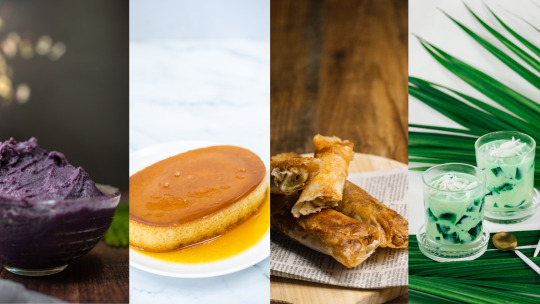
Sweets produce “happiness hormones.” In fact having that sweet dessert after a hearty feast is the most satisfying part of the meal.
Filipinos typically prepare delicious treats that the whole family will enjoy using tropical ingredients like coconuts and fruits. Rice, particularly sticky rice and even glutinous rice, is a common ingredient used in merienda recipes like the famous sapin-sapin and palitaw.
The sweet treats you hear about such as a special Halo-halo are just a tiny portion of the fantastic merienda that Filipinos enjoy! Anyone can have a taste of these authentic Filipino recipes at the Manila Food Mart ,Lake Forest, Orange County.
Let’s see how much you know about some yummy Filipino merienda favorites! Read on!
#1 Buko Pandan
Talking about a crowd pleaser during gatherings, Buko Pandan is one of them. There are three main ingredients in this sweet and cooling Filipino treat: Sweetened cream, gelatin laced with pandan, and coconut.
Is it difficult to prepare? All you need to do is combine all the ingredients with the right proportion, then refrigerate it. A bowl of joy is in your hands after a few hours! Buko Pandan is aromatic and coconutty. This dessert is truly tropical and no wonder, a winner at every birthday party or during simple warm midday.
#2 Cassava Cake
Gluten-free diet? Good news for you!
The name Cassava Cake refers to a classic Filipino cake made with grated cassava and coconut milk coated with molten custard at the top. Its texture is interestingly firm but also soft and just a little chewy. The ingredients used are absolutely gluten-free!
The extra ingredients from making the cake itself also work perfectly as toppings! The most well-liked ones include Macapuno, a sweet type of Filipino coconut, and light cheddar cheese shreds to balance everything. Yum!
#3 Turon
Thought you could never be satisfied with Lumpiang Shanghai? Wait until you try Turon!
Falling in the category of widely consumed lumpia dishes, Turon is one of its sweet varieties. Made with Saba banana and jackfruit wrapped in a thin wheat wrapper, you can never miss this famous Filipino treat hitting the street when it’s Merienda time! Fried to a golden crisp, turon can be drizzled with caramel or dusted with roasted sesame seeds.
#4 Biko
Feel the love of a family member preparing that famous Biko. This tasty merienda favorite demands time and patience to perfect! It involves stirring the sticky rice consistently to prevent it from sticking to the pot and preparing another recipe for the top layer known as Latik. It somehow resembles cassava cake in appearance given that Biko is also a type of rice cake.
This delicious dessert commonly prepared on birthdays, holidays, and special occasions, is sticky, fragrant, and nutty sweet! Why not welcome Biko in your next gathering?
#5 Puto
Despite its neutral flavor, Puto is a favorite rice cake especially when it is served with a tasty dinuguan.
A wide variety of Puto with variations in consistency, form, size, color, and flavor is a product of the playful Pinoy taste bud. Some Puto are cooked with a delicious pork filling while some have variations in flavor like the Ube Puto. Others would rather stick to the usual strip of cheese and salted egg at the top.
Puto is equally as versatile as the Filipinos themselves!
#6 Kutsinta
This orange variant of the traditional Filipino steamed rice cake is just as well-liked and delectable!
Kutsinta has the same fundamental ingredients as most rice cakes, but the presence of food-grade lye produces a thick and chewy texture. Also, brown sugar and annatto seeds are what give it a hint of orange color. It is commonly sold together with Puto, and Filipinos love to eat them together too! Why not give this nostalgic combination a try!
#7 Leche Flan
Leche Flan has that sweet, creamy flavor that nearly no one could possibly resist!
Leche flan may look familiar because it is similar to Creme Caramel. It is a pudding that the Filipinos steam cook with milk, sugar, eggs, and vanilla flavoring. It is so delicious that it smoothly and slowly melts in your mouth!
A perfectly cooked Leche flan has achieved a silky soft texture and is typically oval-shaped for using tin molds called ‘llaneras‘ to prepare.
Serve this simple yet luscious dessert chilled and drizzled with caramel syrup for the perfect indulgence!
#8 Halo-halo
Halo-halo means “mix-mix” or “assorted,” and it perfectly describes the dish’s technique and style! Discover why it’s worthwhile to try this festive Filipino dish that you’ve probably heard about on social media a lot!
Bananas, sweet potatoes, jackfruit, and red mongo beans are among the most commonly used ingredients in this fruit and bean combination summer snack. But do you still remember Leche Flan? It is also one of the more appealing ingredients to add along with various colorful cubes of fruit jellies. It is then finished off with finely crushed ice, milk, and a scoop of Ube ice cream at the top!
Let this combination of various sweet delights and superb eye-pleasing cold dessert comfort you! Visit Manila Food Mart and be ready for a great serving of an authentic Halo-halo.
But wait, a photo of this fresh Halo-halo will surely be great for your next Instagram post!
#9 Taho
Tahooooo?! Anyone?
For many Filipinos, this traditional dessert Taho evokes flashbacks of their youth in the Philippines.
Identical desserts may be found in many Asian countries, especially the silkiest tofu variety. Similar practices apply to Pinoy Taho, but Filipinos prefer a sweet arnibal syrup with tiny sago pearls in their hot Taho.
Early in the morning, street vendors routinely sell this very affordable, tasty, high-protein breakfast item. A cup of Taho is every kid’s favorite treat! How about reliving the nostalgia?
#10 Ube Halaya
There are a lot of tasty desserts and merienda to try in the Philippines. Pinoys love to play around with different sweet treats to find the right balance of taste. Ube Halaya is one of these deliciously well-balanced desserts. It has a soft, creamy consistency and a mildly sweet taste.
Ube Halaya is one of these deliciously well-balanced desserts. Patiently cook a perfect purple yam or Ube with some milk and sugar. Mix to get that sticky, smooth texture and you will have that heavenly Halaya.
Dig in! Enjoy a truly sweet treat that you can never resist!
The Sweet Conclusion
Merienda can mean either sweet or savory food in the Philippines. It is a habit that is hard to break, a time to eat your favorite turon, halo halo or rice cakes!
And whether you have a sweet tooth or none at all, a handful of these Filipino sweet treats for your merienda satisfies those cravings.
Great that Manila Food Mart in Orange County has prepared those authentic and affordable merienda treats for you and your family.
Delight those taste buds! Bring back nostalgia! Visit Us!
#TopcatererOrangeCounty#FilipinoFoodLakeForest#BestCateringOrangeCounty#affordablecateringCA#FilipinoFoodOrangeCounty#ManilaFoodMart
1 note
·
View note
Text
Pinakamasarap na Ube Puto Maya
Pinakamasarap na Ube Puto Maya
For this video, we’ll show you how to make your plain puto maya extra special by just adding ube flavor and cheese. Actually, my mom was just planning to make it plain. But I requested her to add ube flavor and cheese onto it making it so flavorful. So here’s our own version of Ube Puto Maya, I hope you’ll like it.
FYI, Puto maya is a Filipino local snack consisting of glutinous rice cooked in…

View On WordPress
0 notes
Text

a special filipino twist, ube cheese puto 🧀
ingredients:
1 cup all purpose flour (or cake flour/1st class flour)
1 tbsp baking powder
1/4 cup sugar (adjust as needed)
1 medium egg
1/2 cup ube-flavored condensed milk
1 tbsp melted butter (or oil/margarine)
1/2 cup water (or milk)
ube flavored food coloring (optional)
cheese for topping
instructions:
in a bowl, sift together the all purpose flour (or cake flour/1st class flour), baking powder and sugar. mix well, then set aside.
in a separate bowl, combine the egg, ube-flavored condensed milk, melted butter (or oil/margarine) and mix until well combined.
add the wet mixture to the dry ingredients. mix well. add the water (or milk) and add half as you mix. make sure to add enough water until you get the right consistency.
add a few drops of ube flavored food coloring (optional) on the color you want. mix well. the consistency should be not too runny or thick. then rest the batter for at least 10 minutes.
after 10 minutes, grease your molds only in the bottom of the molds to achieve dome appearance with oil and pour the mixture to the molds filling only 3/4 of it as it will rise as you steam. finally, add your cheese on top.
arrange your molds in a steamer and cover the lid with cloth to avoid water drips while steaming. make sure that the water is already boiling before steaming.
if you have large molds, steam for 14 to 15 minutes. if you have medium molds, steam for 10 to 12 minutes. if you have small molds, steam for 8 to 10 minutes.
once done, let it cool for 5 minutes before unmolding.
enjoy!

7 notes
·
View notes
Text
I went to lay down to think of how I wanted to write a fic since I think better laying down and I accidentally fell asleep lmao
#snap chats#at least I know how I wanna write this fic now 😤#I didn’t sleep for long only about an hour I think#I woke up to my bro being like ‘ma brought home ube pan de sal :o’#and I was just lookin at him like :|?#and then he repeated himself and I was all :| 👁👄👁#I love ube and I love pan de sal and I love ube pan de sal#my mom realized that the Filipino store by her work was only eight minutes away from her so she picked up some bread 🤧#I wonder if they have any puto there... that the GOODEST shit 😩#esp with a lil cheese square hehehe#my dad used to get em a lot :)) so good 🤧#lmao I was talkin bout thinkin of dudes sucking each other off now I’m talkin bout bread#so is the enigma of my brain#anyways Maybe expect that fic tonight and I say that so I actually do it 😤#just gonna finish up tea with me ma then I’m gonna scamper up to my room
5 notes
·
View notes
Text
the three dishes | m. osamu × food reader
details: 900+ words | fluff | filo!reader, self-indulgent
summary: can osamu spot the differences between afritada, menudo, and caldereta?
note: there were four similar dishes, actually. there’s also mechado, but i kinda forgot about it. 😂 anyway, this is a bit self-indulgent.

When your parents took your husband to the wet market with them, you were silently hoping that they would make you tag along. But your husband, being an amiable person that he is, didn’t even asked your parents if you could come with them.
After partially cleaning your house, the three of them returned while carrying numerous ecobags that were filled with ingredients for the upcoming party later.
“I’ll show you how to make those dishes,” your mom told your husband while grinning. “You can try making them for your friends once you return to Japan.”
“Is that even possible?” Osamu asked, his voice filled with curiosity as he stares at the ingredients they bought. “Using almost the same ingredients for different dishes?”
“As long as you’ll use something like pork or beef when you’re making them.” Osamu’s forehead suddenly furrowed. “Some of these dishes won’t taste that good if you’ll use chicken.”
You placed the broom and dustpan back to where you kept them before walking towards your husband.
“You weren’t able to try those dishes before, right?” you asked, remembering how disappointed Osamu was when he forgot to ask your mother to make those dishes you’ve been telling him about.
“Yeah. We’ve already boarded when I remembered it,” he replied before kissing your forehead. “Ah, right. We bought some sapin-sapin and plain puto earlier today.”
You reached out for the bags and searched for a plastic with banana leaf in it. “How about you? Have you tried these native delicacies earlier?”
Osamu nodded his head almosy immediately. The gleam in his eyes were so bright that you were almost jealous of the food he ate earlier. “I tried ube halaya and maja blanca, but biko is still my favorite.”
“A well-made biko would single-handedly defeat every native delicacy available,” you said before taking a bite from the sticky delicacy in your hand. While chewing, you noticed your husband’s burning gaze towards your hand. “Samu?”
He blinked, the tips of his ears turning more and more pinkish. “I-I was just curious.” Osamu rubbed the back of his neck before looking at you. “How is it possible to add three colors without mixing them?”
“Well, first—” You began telling him what you know. The colorful sticky dessert that you were holding was already forgotten as you explain the process of how sapin-sapin was done. “—it was fascinating to watch.”
Osamu couldn’t take his eyes off of you as you share what you’ve watched in the past. Although he knew that it was probably something that you weren’t planning to watch at all. ‘That look on her face reminds me of that time we watched Atsumu and Bokuto-san pounding the rice before.’
“Ahem.” He blinked before glancing at your parents who were grinning at him. “Baka matunaw,” one of them commented followed by a snicker.
“Come on, stop teasing my adorable husband,” you said before wrapping your arms around him. “Well, ’Samu. Would you like to help us prepare the ingredients we’ll use?”
He nodded his head in response.
Shortly after, everything that you’ll be using were already on the table, washed and properly cut. Then, they began making three different dishes using the same ingredients, from the meat to the vegetables, while adding more ingredients that would make each dishes unique in their own way.
“All done!” you mother announced after placing each dishes into three separate bowls. “Try it.”
The dish in the first bowl is called afritada. “So, this is the most basic version of these three dishes. It’s made up of pork, potatoes, carrots, and tomato sauce. Of course there’s also salt and pepper added but that’s it.”
Osamu looked at the bowl with a sauce that has thinner sauce compared to the other two. He took a spoonful of it before he looked at your mother. “It’s tasty.”
Your mother grinned while nodding. “Good. Good. Next one.”
He first tried menudo, which was made up of the same ingredients used in afritada, but this time a chicken liver is added. The way the ingredients were cut was also different.
“It’s delicious.”
“You like it now? Well, try the last one.”
The last one’s caldereta. There was supposedly a fourth one, but one of your relatives said that they’ll be the one to make it. Anyway, it’s made of the same ingredients as afritada, but more flavorful. Cheese, liverspread, and red bell pepper were added to this dish. It also has the thickest sauce among all these dishes
Osamu’s eyes twinkled upon tasting the last dish. It was as if he was enchanted by the last dish.
He was speechless!
“Let’s eat first before they arrive one family after another,” your mother said while placing the bigger servings of the three dishes on the table. You placed the rice in the middle before setting the plates in front of your husband and your place and as well as your parents’ spot.
It was probably one of the most peaceful mornings that you’ve spent while visiting the country with your husband, but the day was just getting started.
#keiyoomi: does impulsive shits#haikyuu x reader#haikyuu!! x reader#hq!! x reader#hq x reader#haikyuu x reader fluff#haikyuu!! x reader fluff#hq!! x reader fluff#hq x reader fluff#haikyuu fluff#haikyuu!! fluff#hq fluff#hq!! fluff#miya osamu fluff#miya osamu x reader#miya osamu x reader fluff#osamu x reader#osamu fluff#osamu x reader fluff
65 notes
·
View notes
Text

1. Halo-Halo (Mix-Mix)
lutong-bahay-halo-halo
Halo Halo by klaurico
Undoubtedly one of the best desserts that the Philippines has. Halo-halo is a dessert that is made up of shaved ice and is topped with condensed milk along with many other sweet toppings. That includes ice cream, ube halaya, leche flan, jellies, beans, etc. And it is easy to find in many small and big stores anywhere in the country as well.
What makes halo-halo interesting is its origin. Its basic principle traces back to desserts that mainly use shaved ice with sweet toppings. But it is closest to Kakigori, which is a Japanese dessert that has sweet beans on top of shaved ice.
The Japanese brought such dessert into the Philippines around the early stages of World War II. Luckily, ice plants were already in the country during those years, especially after the Americans built the first one in 1902. Then, the Filipino creativity just kicked in by adding more applicable toppings on the dessert, until it became a unique cold treat on its own.
2. Leche Flan
lutong-bahay-leche-flan
Leche Flan, To order contact unclereyskitchen
You can’t talk about the best Filipino desserts without mentioning leche flan. It is the Philippine take of the European crème caramel, and is also made from steamed or baked egg yolk with sweetened milk and caramel. And it also carries a rich backstory from the days of Spanish occupation in the archipelago.
Before, Spaniards put egg white into their concrete mixtures that they use for building different infrastructures. This means discarding so much egg yolk that they don’t need. That’s why Filipinos tried to find ways on how to use those leftovers. As a result, the yummy leche flan came to be.
3. Puto and Kutsinta
lutong-bahay-puto-and-kutsinta
Puto and Kutsinta by im_jezanaih
Puto and kutsinta are popular steamed rice cakes that Filipinos love to have as snacks or desserts. Puto is often paired with savory Filipino food such as dinuguan and pancit, whereas kutsinta is often topped with grated coconut.
Filipinos also love to have puto and kutsinta during the Misa de Gallo or Dawn Mass at the Christmas season. This is partially because of Lakapati (also known as Ikapati), who is the goddess of agriculture and prosperity of the pre-Hispanic Tagalog people.
Ancient people used to make rice cakes among other delicacies as tribute for Lakapati, which is supposed to get a good harvest on the following year. Such practice was Christianized by the Spaniards, became famous during Misa de Gallo, and continues until today.
That means keeping a good number of the best Filipino desserts for the present folks to enjoy, of course.
4. Filipino Ice Cream
lutong-bahay-ice-cream-pinoy
Pinoy Ice Cream by
Of course, Filipinos love ice cream too, just like how others in the world do. But ice cream brings some unique experiences for everybody in the country.
First, the biggest ice cream brands in the Philippines have unique flavors that you can’t easily find with western ice cream. Yes, they offer the classic chocolate, vanilla, rocky road etc. But they have ube, buko pandan, and mango among other unique flavors as well. Cheese ice cream is even available around.
And second, dirty ice cream or Sorbetes is an ice cream variation that is truly Filipino. It has its roots when some American traders brought tons of ice from the USA to the Philippines around 1840’s. Sorbetes is manually made by mixing ice, carabao milk, and fruits in a container. But today, the sorbetes is traditionally sold by peddlers on the streets using their small ice cream carts.
5. Ube Halaya
lutong-bahay-ube-halaya
Ube Halaya by preciousjuniar
Ube is a popular flavor and topping for many desserts in the Philippines. It is even more popular than vanilla in the archipelago, as well as it has reached other countries worldwide too. Ube is a purple root crop that is a cousin of sweet potato and are tropical plants that are abundant in the Philippines.
Now, Ube Halaya is made from boiled ube root and is then grated before use. It is cooked with sugar and coconut milk
among other ingredients until it turns into a jam. It is uncertain how ube halaya was discovered by Filipinos and became one of the best Filipino desserts. But it is a widely used ingredient for many other desserts today, such as Halo-Halo, ice cream, cakes, and turon.
Enjoy the Best Filipino Desserts through Sweet and Unique Ways Today
Ready to try some of the best Filipino desserts today? Begin with the list above to enjoy Philippine delicacies that bring a lot of stories to you. Just remember that Filipino desserts aren’t necessarily eaten after meals, since they’re typically enjoyed during snacks and breakfast too. Choose one that fits your taste today!
3 notes
·
View notes
Photo
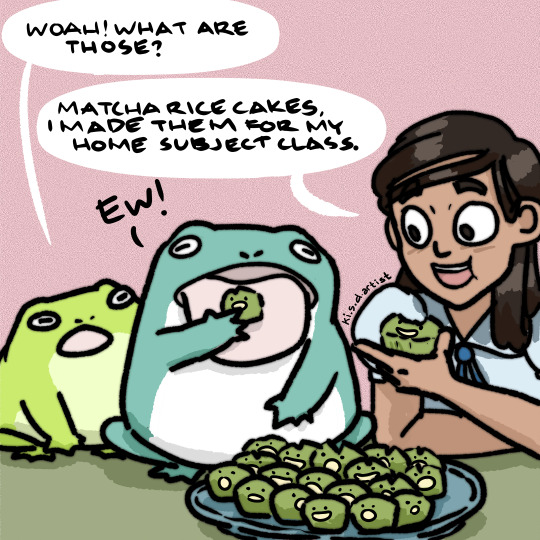
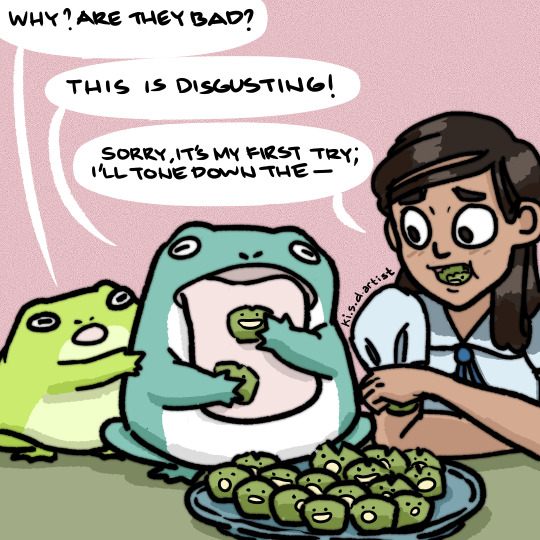
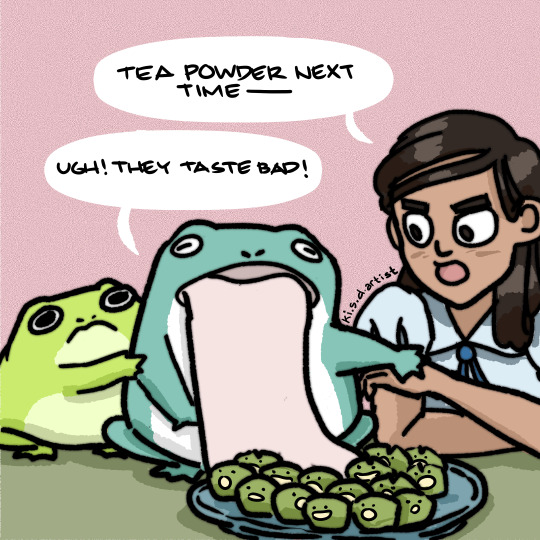
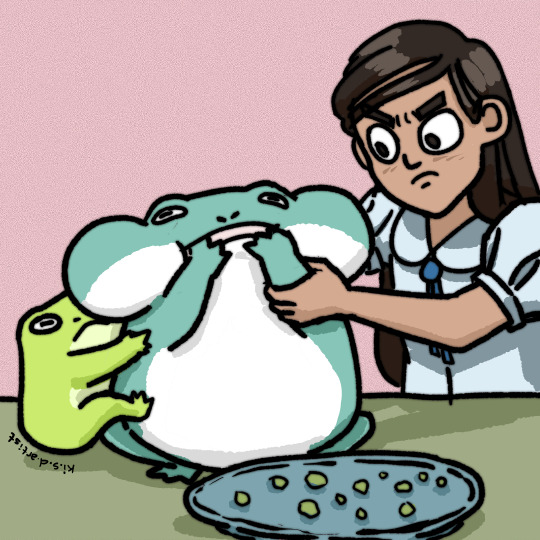
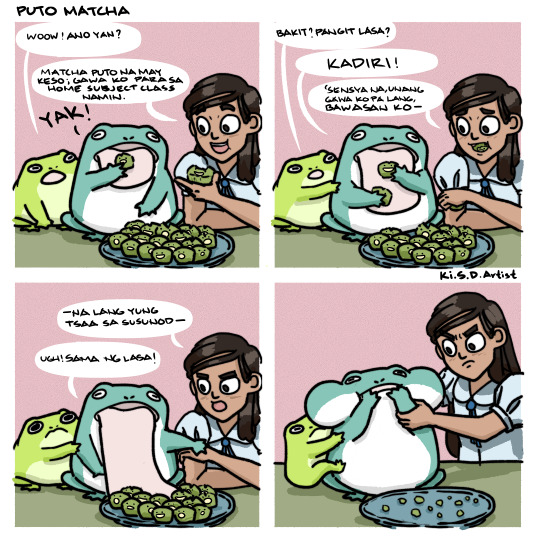
Matcha ricecakes - Paz, Pol and Keyli comics
Every food must be tasted by Pol first, for safety.
A ricecake/puto might sound like a bland dessert, and might also sound like a Spanish derogatory word but its actually a favourite treat here in my country. It was influenced from the Indian/Malay food Puttu, way back during precolonial times. The dessert varies from region to region; some are baked in claypots, some in bamboos and most are steamed. Some have cheese and some have salted eggs. Its really easy to make, or easy to come by in my country, if you ever pass by here. Modern concoctions have flavors now like Ube and Matcha to accommodate modern tastebuds.
#frogspotting#frog#phrog#palaka#artph#frogmemes#ropucha#broasca#comics#rana#comicstrip#zaba#frosch#grenouille#dopamine#seretonin#dailycomics#matcha#foodph#pinoyfood#frogph#kikker#カエル#मेंढक#레인프록#kodok#лягушка#กบ
4 notes
·
View notes
Photo

Flavours of Manila
The balance of sweet, salty, sour and bitter is not unusual in South-East Asian profiles - I’ve spent six months in Thailand, and also am super familiar with Vietnamese, Laos and Cambodian foods through my family’s heritage, so I’m no stranger to garlic, vinegar, fish sauce, lemongrass, palm sugar, tamardinds. And then I came to the Philippines, and everything felt familiar but also strangely different. I haven’t really been able to put my finger on it - for every dish I’ve tried here, I can think of something similar in a different cuisine but it’s all just a little off? Anyway, I’ve tried quite a few dishes in my six months here - here’s a quick round-up:
HITS:
Dinuguan - pigs blood stew, often served with puto (rice cakes). The puto is spongey and slightly sweet, and the stew is rich with unctuous chunks of pork. Once you get over the slight ick factor associated with blood, it’s incredibly delicious.
Halo-halo: this is the local answer to iced kachang or bingsu - it’s basically flavoured shaved ice. The base Filipino variation uses ube, red beans, and slices of leche flan, topped with plenty of condensed and evaporated milk. This is delicious in the way that ice-cream is delicious - you can’t reallllllly get it wrong.
Tokwa’t Baboy - deep fried tofu with pig ears. Served as a snack, and liberally doused in a vinegary sauce, the combination of chewy pig ears, pillowy tofu and crisp rings of red onion are texturally amazing and incredibly moreish.
Ube anything - very similar to taro, ube is a starchy, sweet root vegetable which is used liberally in desserts. It’s pictured above as a shake, but it features prominently in all types of filopino cuisine: breads, cakes, ice-cream, etc. It’s frequently paired with cheese which admittedly sounds kinda weird but it works..
OKAY:
Adobo: This dish is so famous, but I find it pretty average. It’s just another marinated meat, and I think there are too many other versions for this to be a stand-out.
Crispy Pata: deep-fried pig trotters. To be fair, I do appreciate the balance between the meat and the vinegar dipping sauce (very moreish) but it’s not a particularly exciting dish. It’s probably fine to share but it’s not something I’d order again on my own.
Kare-kare - a thick stew made with a peanut-base, and slow-braised oxtail. The creamy peanut base is offset with a sharper shrimp paste to create a rich complexity and depth of flavour. Paired with rice and bagoong (shrimp paste) which helps cut through the richness of the sauce, it’s a solid and repeatable dish though some places do it better than others. (There’s also a pretty good version @ 711.)
MISS:
Bibingka - a cake-style dessert made with rice-flour. The texture is soft and dense, and it’s flavoured with sugar and topped with cheese, salted egg and coconut; then served liberally doused with butter. It is ... a lot. And a bit too much. I really couldn’t get on board with how every flavour is trying to compete in your mouth.
Sinigang - a sour soup flavoured with tamarind. Usually includes juicy beef rib bones with lots of tender flesh, and lots of green beans and tomatoes. Reminds me of canh chua, but much more sour and more viscous in texture.
Pancit Luglug - this is the first dish I’ve ever violently hated. The base ingredients are normal (noodles, egg, pork) but the methodology is terrible - the pork rinds leave a terrible dusty texture in your mouth, and the flavour is just salty with no depth. Don’t order this, ever.
2 notes
·
View notes